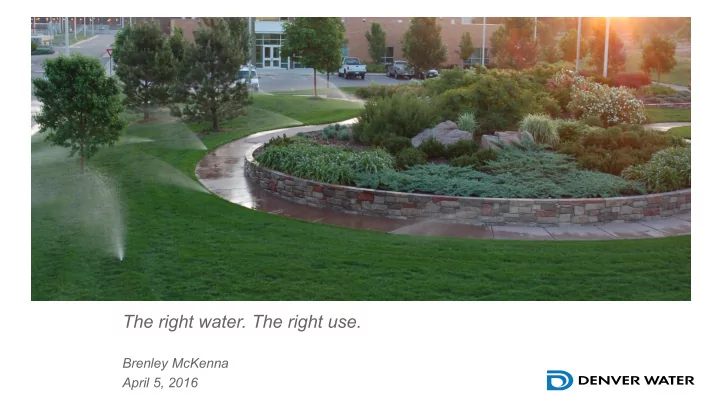

The right water. The right use. Brenley McKenna April 5, 2016
Presentation Objectives • Current Regulation 84 • Proposed Changes • Approach • Address Total Dissolved Solids and Salinity • Drivers for Increased Reuse 2 8/2/2017
Regulation 84 “It is the intent of the Commission that this regulation further promote reuse of reclaimed domestic wastewater by providing a comprehensive framework which, when followed, will assure responsible management of operations and a product of a quality compatible with the state's goals of protecting the public health and the environment...” 84.21 B 3 8/2/2017
Current Regulatory Framework Level of Uses Restrictions Treatment Category 1 Few Many Category 2 Category 3 Many Few 4 8/2/2017
Proposed Changes Level of Uses Restrictions Treatment Category 1 Few Many Category 2 Category 3 Category 4 Category 5 Many Few 5 8/2/2017
Proposed Changes to Regulation 84 • New Categories and Uses: – Category 3 • Livestock wash-down – Category 4 • Commercial agriculture for edible crops • Toilet flushing – Category 5 • Edible crops in urban gardens 6 8/2/2017
Proposed Changes Level of Uses Restrictions Treatment Category 1 Few Many Category 2 Category 3 Category 4 Category 5 Many Few 7 8/2/2017
Approach • White Paper for Edible Crops • Model changes after other states regulations – Goal: • Protection of human health and the environment • Minimize Risk • Increase utilization of recycled water 8 8/2/2017
Variations in Water Quality Requirements • Disinfection (CT values, residual, log removal) • Total Coliform/ E. coli • Turbidity • Monitoring • Redundancy • Treatment Most Stringent Least Stringent WA AZ TX CA ID OR 9 8/2/2017
Idaho: Reclaimed Water Quality 10 8/2/2017
Operational Considerations • Access • Training • Cross connection test • Backflow requirements • Signage • Dual plumbing 11 8/2/2017
Considerations for Changes to Regulation 84 • Change of Definitions – Reclaimed Water – Restricted Access/ Unrestricted Access – Toilet/ Urinal Flushing – Trained Worker – Commercial Agriculture – Agricultural Irrigation – Agricultural Irrigation User 12 8/2/2017
TDS AND SALINITY 13 8/2/2017
Agronomic Principles • Plant physiology: plant life depends on water • All water contains some salt • Salts include nutrients essential for plant growth and health • Sodium is not an essential nutrient • Chloride is essential at extremely low concentrations, as is boron • Too much of anything (including salts) can be toxic to plants • Environmental stressors can complicate the picture 8/2/2017 14
Water Quality Parameters and Landscape Health Management and Restrictions None Slight to Moderate Severe Salinity – EC (dS/m) Tempe, AZ Drinking Water Quality 0.7 Constituent Range Average 3.0 0.995 Salinity (EC) Sodium – Na (mg/L) (dS/m) .693-2.170 1.194 70 110 Sodium (mg/l) 50-350 152 Boron – B (mg/L) Boron (mg/l) 0.13-.6 0.15 0.28 0.7 3.0 Chloride (mg/l) 60-420 215 Chloride – Cl (mg/L) Source:2014 Tempe Water Quality Report 162 100 Source: Average 2015 Irrigation Season Water Quality 15 8/2/2017
Water Quality Parameters and Landscape Health Restrictions None Slight to Moderate Severe Salinity – EC (dS/m) Tempe, AZ Drinking Water Quality 0.7 Constituent Range Average 3.0 0.995 Salinity (EC) Sodium – Na (mg/L) (ds/m) .693-2.170 1.194 70 110 Sodium (mg/l) 50-350 152 Boron – B (mg/L) Boron (mg/l) 0.13-.6 0.15 0.28 0.7 3.0 Chloride (mg/l) 60-420 215 Chloride – Cl (mg/L) 162 100 Source:2014 Tempe Water Quality Report Source: Average 2015 Irrigation Season Water Quality 16 8/2/2017
Site Maintenance: Management vs. Treatment • Similarities with Potable Water: – Right Plant in the Right Place – Know Your Soil Characteristics – Know Your Water Quality and the Best Irrigation Method • Differences from Potable: – Monitor More Frequently – Test Soil Routinely – Leach/Amend Soil to Prevent Salt Accumulation – Reduce or Eliminate Fertilizer Salts 17 8/2/2017
DRIVERS FOR INCREASED REUSE 18 8/2/2017
Colorado’s Water Plan • Guidance document specifically named reuse as an aid in reducing the water supply gap. • 8 Actions specific to increasing reuse in Colorado – Increasing funding and incentives for water recycling and expanding the list of uses for which recycled water can be applied. 19 8/2/2017
One Water In Practice • Uses the most appropriate source water for each water use • Avoids using potable water for non-potable purposes • Minimizes potable water demand through conservation measures • Minimizes discharges to the environment through resources recovery and reuse 20 8/2/2017
Questions? 21 8/2/2017
Contact Information Brenley McKenna Reusable Water Program Manager 303.628.6011 brenley.mckenna@denverwater.org Damian Higham Recycled Water Specialist 303.628.6537 damian.higham@denverwater.org 22 8/2/2017
Back Up Slides 23 8/2/2017
Other Sources of Salinity • There are many other sources of salinity both natural and anthropogenic that can impact landscape health: • Agricultural practices • Commercial and industrial activity • Road/ sidewalk de-icing activities • Water softeners • Household cleaning products • Inflow & Infiltration • Ground water • Treatment chemicals • Fertilizer 24 8/2/2017
Texas: Type 1 Reclaimed Water Quality 25 8/2/2017
Colorado: Category 3 Reclaimed Water 26 8/2/2017
27 8/2/2017
Salinity and Sodicity Levels Parameter Acceptable Level* Average DW 2015 Levels Salinity Less than 4 dS/m 0.98 dS/m Sodicity Less than 12-15 % 4.43% * These levels will vary based on soil type and species tolerance levels. Management is still recommended for concentrations within the acceptable level. 28 8/2/2017
On-Site Use; New Uses for Reclaimed Water 29 8/2/2017
Conventional Water Flow Normal water flow is linear and single-use. Potable water is discharged to sanitary sewer after use. Rainwater flows to storm sewer. 30 8/2/2017
Recommend
More recommend